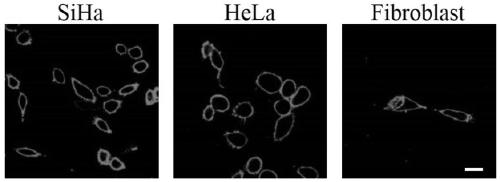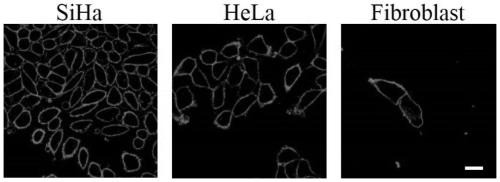Fluorescent probe for rapidly displaying normal state and near-zero state of potential of cell membrane and application thereof
A fluorescent probe, normal state technology, applied in the field of fluorescent probes, to achieve the effect of eliminating tedious steps, high specificity and high selectivity
- Summary
- Abstract
- Description
- Claims
- Application Information
AI Technical Summary
Problems solved by technology
Method used
Image
Examples
Embodiment 1
[0029] Example 1 Preparation of the fluorescent probe (CQ12) that quickly displays the normal state and near-zero state of cell membrane potential according to the present invention
[0030] Add 0.399g of N-dodecylcarbazole-3-formaldehyde, 5ml of ethanol, and protect with nitrogen in a dry three-necked flask. The temperature is increased to 60°C and all dissolved after heating for 30min. Add the compound 1-(2-hydroxyethyl ) 0.315g of 4-methylquinoline iodide salt, add 5 drops of piperidine, heat to reflux overnight, stop heating, evaporate the solvent after cooling, recrystallize with ethanol, and dry to obtain 0.2g of red powder, yield 30% is CQ12.
[0031] The reaction formula for preparing the compound CQ12 is as follows:
[0032]
[0033] 1 H NMR (400MHz, DMSO-d6), δ (ppm): 9.18 (d, J = 8Hz, 1H), 9.15 (d, J = 8Hz, 1H), 8.89 (d, J = 1.6Hz, 1H), 8.56 (d,J=8.6Hz,1H), 8.52(d,J=6.4Hz,1H), 8.42(q,J=9.2Hz,2H), 8.25(t,J=8.8Hz,2H), 8.14(d ,J=8.8Hz,1H),8.07(t,J=7.6Hz,1H),7.77(d,J=8.4Hz,...
Embodiment 2
[0034] Example 2 Cultivation of cancer cells (SiHa and HeLa) and normal cells (Fibroblast)
[0035] At 37℃, 5% CO 2 In a saturated humidity incubator, the SiHa, HeLa and Fibroblast cell lines were grown adherently in H-DMEM culture medium containing 10% fetal bovine serum (containing 1% double antibody). After the cells have grown to the logarithmic phase, SiHa, HeLa, and Fibroblast cells were spliced and cultured. The specific method is: ①Soak the cover glass in absolute ethanol for 30 minutes, put it in a disposable 35mm petri dish after drying with an alcohol lamp; ②Wash the cells that grow to the logarithmic phase in the cell dish three times with PBS. After digesting with 1mL 0.25% trypsin for 3-5 minutes, carefully pour out the enzyme solution, add a small amount of fresh culture solution, pipette the cells to make a uniform cell suspension, after the cell count, use the cell culture solution to adjust the final cell concentration 1×10 5 Pieces / ml, inoculate into a petri...
Embodiment 3
[0036] Example 3 Fluorescent probe CQ12 stains live SiHa, HeLa and Fibroblast cells
[0037] The cell slides prepared in Example 2 were washed three times with PBS, and live SiHa, HeLa and Fibroblast cells were stained with 2μM CQ12, incubated at room temperature for 20 minutes, then aspirated the culture medium, and washed three times with PBS to remove unbound cells The cell growth side is covered on a glass slide, and the cell coloring part, fluorescence distribution and brightness change are observed under the excitation of 473nm laser with a laser scanning confocal fluorescence microscope. It is found that the fluorescent probe CQ12 can pass through The cell membrane enters the cell, and the cell membrane and cytoplasm are stained, emitting bright red fluorescence.
[0038] See the result figure 1 .
[0039] The results suggest that the membrane potential state of living cells is normal. When the cell is in the normal membrane potential state, the fluorescent probe CQ12 can eas...
PUM
 Login to View More
Login to View More Abstract
Description
Claims
Application Information
 Login to View More
Login to View More - R&D
- Intellectual Property
- Life Sciences
- Materials
- Tech Scout
- Unparalleled Data Quality
- Higher Quality Content
- 60% Fewer Hallucinations
Browse by: Latest US Patents, China's latest patents, Technical Efficacy Thesaurus, Application Domain, Technology Topic, Popular Technical Reports.
© 2025 PatSnap. All rights reserved.Legal|Privacy policy|Modern Slavery Act Transparency Statement|Sitemap|About US| Contact US: help@patsnap.com



